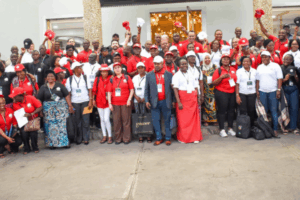Pholo Sebotsa, the Head of the Engineering Sector at the National Union of Metal Workers of South Africa (NUMSA), shares what constitutes an effective bargaining process for the union and the private sector context, focusing on negotiations at metal industry giants such as Macsteel and Mittal Group, and other players like Nampaq.
Wage bargaining seasons in South Africa are critical moments where trade unions negotiate with employers for fair wages, improved working conditions, and broader social justice. As the 2024 wage bargaining season unfolds and unions brace themselves for the intense negotiations ahead, some key factors and strategies will be necessary to employ.
NUMSA’s primary objectives for their members include securing higher wage increases in line with inflation, improved overall conditions for workers, access to various allowances, and ensuring that workers benefit from the company’s profits and can adequately provide for their families. Sebotsa shared valuable insights into the challenges and strategies involved in negotiating in the private sector and emphasised the importance of collective bargaining in ensuring that the interests of workers are well taken care of, including getting better wages, improved conditions of service, and access to benefits like medical aid and housing. He explained the process of preparing for negotiations, which involves obtaining mandates from members at various levels, starting from plant-level meetings to regional and national levels, and forming a unified negotiation position.
“We are worker-driven and mandate-driven. There’s the principle that says nothing for us without us.”
Sebotsa stressed that negotiations are often complicated, and the union is usually faced with the delicate balance between securing high wages and maintaining job stability, especially when company performance across their membership sectors varies.
If, for example, company A is performing better than company B, it’s not easy to make the same demands of the different companies given their various strengths in profitability and market-related challenges like load shedding and general economic downturn in the country. This requires the union to unify its approach without disadvantaging any group within its membership and, most importantly, without risking retrenchment for its members. However, this approach requires transparency in company finances during negotiations to ensure that all parties are informed and can negotiate effectively. To this end, NUMSA often relies on shop stewards on the ground to inform them of how their respective companies have performed.
When negotiations don’t go as planned, negotiators are compelled to return to their members with unfavourable outcomes. During high-level talks, unions like NUMSA try to keep their members ready for the eventuality of striking and the possibility of lunchtime pickets. While striking is often an effective way of attaining worker’s demands once negotiation fails, unions are also weary of taking to the streets without the support of all their members. One of the trends this season, according to Sebotsa, is that companies are growing sharper and dividing the workforce, with stronger-performing companies offering generous increases to some of their members when, in contrast, other companies cannot do the same.
“Now, when we come to real financial resources, we have our T-shirts ready to mobilise the members so that, at all material times, the members remain ready for any eventuality…because in unions, we always use the language that ‘you cannot win in a boardroom what you have not won in the streets. (However), you also don’t want to go on a strike that is not going to be impactful.”
Five key factors for private sector negotiators
In light of Sebotsa’s insights, here are five key factors that private sector negotiators must consider as they prepare for and navigate the challenges ahead:
1. Preparation
When it comes to effective negotiation, preparation is the most crucial component. Preparations help negotiators renew their strategy and approach and give them overall confidence when entering the negotiation room. Preparation requires a comprehensive understanding of trends and economic contexts. This involves doing research on current inflation rates, industry performance, and the individual performance of the companies in question and comparing wage data from across the sector and other similar sectors. Negotiators also need to get their negotiating mandate from the workers they represent. Collecting worker-centric data at the plant level to the regional level gives unions an idea of what their members need and expect from negotiations.
“My role is to make sure that our respective officials at various regions are represented, because we don’t have provinces, we’ve got regions. My role also involves making sure that engineering sector workers, specifically members of NUMSA, are well taken care of, receive the best service from local organisers, and basically just enjoying the benefits of joining the union every three years.”
2. Weighing out the challenges in negotiation
This current negotiation season is not without challenges. As can be anticipated, companies also prepare rigorously, as it is in their best interest to avoid negotiating with unions. To avoid negotiations, many companies approach their workers directly, offering them pre-emptive wage increases, which they hope will potentially undermine the unity and bargaining power of the union. This can be frustrating for unions. However, in the face of these tactics, unions must maintain solidarity with their members to avoid interception.
The current economic context in South Africa has been challenging for companies. The COVID-10 pandemic exacerbated this financial constraint. While the steel and metal industry is steadily recovering with an upward growth trajectory, Trade Unions must also balance the companies’ realistic economic constraints with the workers’ demands. Combining comparative wage data and benchmarks from similar industries to justify wage demands will ensure that demands are grounded in industry standards. This is a delicate task, but balance is essential for a favourable outcome.
For this bargaining season, NUMSA consolidated its members’ individual and collective mandates. With this data, the union plans to align worker mandates with the comparative wage data to form a unified negotiation strategy.
3. Getting the right support:
Unions cannot go at it alone. It is in the interest of workers for unions to have evidence-based data and insights on the industries within which they are negotiating. This will help them form strong arguments around recommendations that can be leveraged during discussions with employers. The Labour Research Service (LRS) is instrumental in backing unions with data, insights, tools and resources that can help them shape informed negotiation strategies. These resources are crucial for grounding union demands in empirical data and market trends. Some examples of essential tools for negotiators are the LRS Negotiators Guide, Inflation Monitor, and the Wage Calculator.
4. Strategies to employ at the negotiating table:
The negotiation process involves strategic presentation, timing of demands, and the ability to make informed compromises. Effective communication and adaptability in response to shifting economic landscapes are key to successfully navigating the negotiation process. Negotiators must develop a negotiation strategy that includes an ideal position, a realistic fallback plan, and a clear bottom line that they are pursuing. This allows unions to be adaptable in negotiations and to respond to changing dynamics during the discussions.
5. Considering the road ahead
Negotiations don’t happen in a vacuum. As negotiations progress, the outcomes will have significant implications not only for workers, union members, and companies but also for the broader economy and South Africa’s industrial landscape. The negotiation period will test the resilience, unity, and strategic intelligence of all stakeholders involved and could set new precedents for labour negotiations in the country. Unions must keep this in mind. Despite any gains achieved or losses incurred on behalf of workers, unions must have a futuristic outlook as they spear ahead.
Five factors negotiators must consider
For all stakeholders involved in bargaining, this season is more than just about agreeing on numbers and working conditions. It’s also about setting a sustainable precedent for fair labour practices and economic equity going forward. If all stakeholders can show resilience, unity, and adaptability, the negotiation outcomes can set a positive precedent for cohesive negotiations in the future.
_____
Read: NUMSA secures above inflation wage deal and a historic housing deal for workers in the Engineering sector in 2024.
Explore the LRS Agreements Database and Actual Wage Rates Database to access collective agreements spanning over a decade.
RELATED VIDEO: Wage bargaining: Insights from CEPPWAWU’s approach







